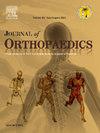Is limb overcorrection following total knee arthroplasty compromising functional outcome?
IF 1.5
Q3 ORTHOPEDICS
引用次数: 0
Abstract
Purpose
Many patients remain unsatisfied after total knee arthroplasty (TKA). Personalized alignment strategies have gained popularity in the search to improve patient satisfaction and function. This study aimed to examine the impact of limb overcorrection in the coronal plane on patient satisfaction and functional outcome. The secondary aim was to investigate how a change in knee phenotype following TKA affects clinical outcome.
Methods
A retrospective matched case-control study was designed between patients with limb overcorrection (N = 37) and a control group (N = 104). Mean follow-up was 68 months. Satisfaction and function were compared by means of the new 2011 Knee Society Score (KSS) and the Knee Injury and Osteoarthritis Outcome Score (KOOS). Radiological evaluation was performed on weight-bearing full-leg radiographs. Overcorrection was defined as a mechanical HKA (mHKA) angle of 2° or more and opposite to the preoperative alignment. The control group consisted of TKAs that were corrected to neutral or left in slight undercorrection. Finally, component alignment (lateral distal femoral angle (LDFA) and medial proximal tibial angle (MPTA)) and Coronal Plane Alignment of the knee (CPAK) phenotypes were evaluated.
Results
The overcorrection group performed better than the control group in terms of KSS subscores satisfaction and functional activities, total KSS score, all KOOS subcategories, and total KOOS score. Subdivision of the control group into a neutral and undercorrection group, and the overcorrection group into mild and severe overcorrection, revealed similar findings.
A chance in knee phenotype as per aHKA, JLO or CPAK did not result in worse clinical outcomes.
Conclusion
Accidental limb overcorrection after TKA does not result in inferior clinical outcomes or patient satisfaction at midterm follow-up.
The present study could not identify an optimal coronal alignment target. This suggests that coronal alignment as a predictor of patient satisfaction and function is likely less important than previously believed.
Level of evidence
Level III, retrospective case-control study.
全膝关节置换术后肢体过度矫正是否会影响功能效果?
目的 许多患者在接受全膝关节置换术(TKA)后仍不满意。为了提高患者的满意度和功能,个性化的对位策略越来越受欢迎。本研究旨在探讨冠状面上肢体过度矫正对患者满意度和功能结果的影响。方法在肢体过矫患者(37 人)和对照组(104 人)之间设计了一项回顾性匹配病例对照研究。平均随访时间为 68 个月。通过2011年新版膝关节协会评分(KSS)和膝关节损伤与骨关节炎结果评分(KOOS)对满意度和功能进行了比较。放射学评估通过负重全腿X光片进行。过度矫正的定义是机械HKA(mHKA)角度达到或超过2°,并且与术前对位相反。对照组包括矫正为中性或轻微矫正不足的 TKA。最后,对组件对位(股骨远端外侧角(LDFA)和胫骨近端内侧角(MPTA))和膝关节冠状面对位(CPAK)表型进行了评估。结果过度矫正组在KSS子评分满意度和功能活动、KSS总评分、所有KOOS子类别和KOOS总评分方面的表现优于对照组。将对照组细分为中性和矫正不足组,将过度矫正组细分为轻度和重度过度矫正组,也得出了类似的结果。根据aHKA、JLO或CPAK,膝关节表型的偶然性不会导致更差的临床结果。这表明,冠状对位作为预测患者满意度和功能的指标,其重要性可能不如之前认为的那么重要。
本文章由计算机程序翻译,如有差异,请以英文原文为准。
求助全文
约1分钟内获得全文
求助全文
来源期刊

Journal of orthopaedics
ORTHOPEDICS-
CiteScore
3.50
自引率
6.70%
发文量
202
审稿时长
56 days
期刊介绍:
Journal of Orthopaedics aims to be a leading journal in orthopaedics and contribute towards the improvement of quality of orthopedic health care. The journal publishes original research work and review articles related to different aspects of orthopaedics including Arthroplasty, Arthroscopy, Sports Medicine, Trauma, Spine and Spinal deformities, Pediatric orthopaedics, limb reconstruction procedures, hand surgery, and orthopaedic oncology. It also publishes articles on continuing education, health-related information, case reports and letters to the editor. It is requested to note that the journal has an international readership and all submissions should be aimed at specifying something about the setting in which the work was conducted. Authors must also provide any specific reasons for the research and also provide an elaborate description of the results.
 求助内容:
求助内容: 应助结果提醒方式:
应助结果提醒方式:


